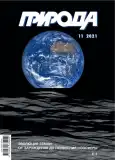Earth’s Evolution: from the Beginning to the Origin of the Noosphere
- Authors: Kuzmin M.I1, Yarmolyuk V.V2, Goryachev N.A1,3, Didenko A.N4,5
-
Affiliations:
- Vinogradov Institute of Geochemistry, Siberian Branch of RAS
- Institute of Geology of Ore Deposits, Petrography, Mineralogy, and Geochemistry, RAS
- Shilo North-Eastern Interdisciplinary Scientific Research Institute, Far Eastern Branch of RAS
- Kosygin Institute of Tectonics and Geophysics, Far Eastern Branch of RAS
- Pacific National University
- Issue: No 11 (2021)
- Pages: 3-16
- Section: Articles
- URL: https://journals.eco-vector.com/0032-874X/article/view/628073
- DOI: https://doi.org/10.7868/S0032874X21110016
- ID: 628073
Cite item
Abstract
The article discusses the geological history of Earth from its formation to the present day. Our planet originated in the Solar System approximately 9.2 billion years after the emergence of the Universe. During the Chaotian eon (4568–4500 million years ago), Earth accreted and differentiated into the core and mantle; the Moon formed. The geological history of our planet began in the Hadean eon (4.5–4.0 billion years ago). During this period, its formation was controlled by constant asteroid bombardment. Since the early Archean eon (4.0–3.1 billion years ago), the leading role was played not by cosmic factors, but by the tectonic mechanisms of the overlying shell as well as by the mantle convection. Both these processes provided the differentiation of the Earth’s depths under higher temperatures. At this stage, the Earth’s solid iron core formed out. During the transition period (3.1–2.0 billion years ago), the main tectonic regime was the tectonics of small lithospheric plates; the rate of crust formation sharply increased; the asthenosphere evolved in the structure of the upper mantle; and layer D″ was formed in the lower mantle. The late period of geological history (<2 billion years) was controlled by the processes of global tectonics, which included tectonics of lithospheric plates and of mantle plumes. They determined the supercontinent cyclicity of the Earth’s development as well as a sharp increase in metallogenic diversity. In general, the geological evolution of Earth is characterized by a complication of the Earth’s structure and origin and consolidation of various geospheres, including the biosphere and the noosphere. Its main result is the formation on our planet of conditions for the origin and successful development of man and human civilization.
About the authors
M. I Kuzmin
Vinogradov Institute of Geochemistry, Siberian Branch of RAS
Email: kotom@igc.irk.ru
Irkutsk, Russia
V. V Yarmolyuk
Institute of Geology of Ore Deposits, Petrography, Mineralogy, and Geochemistry, RAS
Email: yarm1945@mail.ru
Moscow, Russia
N. A Goryachev
Vinogradov Institute of Geochemistry, Siberian Branch of RAS; Shilo North-Eastern Interdisciplinary Scientific Research Institute, Far Eastern Branch of RAS
Email: goryachev@neisri.ru
Irkutsk, Russia; Magadan, Russia
A. N Didenko
Kosygin Institute of Tectonics and Geophysics, Far Eastern Branch of RAS; Pacific National University
Email: itig@itig.as.khb.ru
Khabarovsk, Russia; Khabarovsk, Russia
References
- Геологическая эволюция Земли: от космической пыли до обители человечества. Отв. ред. М.И.Кузьмин, В.В.Ярмолюк. Новосибирск, 2021.
- Гриббин Дж. Одни посреди Млечного Пути (об уникальности планеты Земля и появлении на ней разумной жизни). В мире науки. 2018; 11: 162–168.
- Батыгин К., Лафлин Г., Морбиделли А. Рожденные из хаоса. В мире науки. 2016; 7: 16–27.
- Wood B. The formation and differentiation of Earth. Physics Today. 2011; 64(12): 40–45.
- Костицын Ю.А. Возраст земного ядра по изотопным данным: согласование Hf—W и U—Pb систем. Геохимия. 2012; 6: 531–554.
- Condie K.C. Earth as an Evolving Planetary System. Amsterdam, 2011.
- Nebel O., Rapp R.P, Yaxley G.M. The role of detrital zircons in Hadean crustal research. Lithos. 2014; 190–191: 313–327.
- O’Neil J., Carlsona R.W., Paquetteb J.L., Francisc D. Formation age and metamorphic history of the Nuvvuagittuq Greenstone Belt. Precamb. Res. 2012; 220–221: 23–44.
- Bédard J.H. Stagnant lids and mantle overturns: Implications for Archaean tectonics, magmagenesis, crustal growth, mantle evolution, and the start of plate tectonics. Geoscience Frontiers. 2018; 9: 19–49.
- Ярмолюк В.В., Кузьмин М.И., Донская Т.В. и др. Переходный период в геологической истории Земли между 3 до 2 млрд лет. Геология и геофизика. 2021; 62(1): 31–57.
- Condie K.C., Aster R.C., van Hunen J. A great thermal divergence in the mantle beginning 2.5 Ga: geochemical constraints from greenstone basalts and komatiites. Geoscience Frontiers. 2016; 7: 543–553.
- Кузьмин М.И., Ярмолюк В.В. Тектоника плит и мантийные плюмы — основа эндогенной тектонической активности Земли последние 2 млрд лет. Геология и геофизика. 2016; 57(1): 11–30.
- Tang M., Chen K., Rudnick R.L. Archean upper crust transition from mafic to felsic marks the onset of plate tectonics. Science. 2016; 351: 372–376.
- Pearson D.G., Parman S.W., Nowell G.M. A link between large mantle melting events and continent growth seen in osmium isotopes. Nature. 2007; 449: 202–205. doi: 10.1038/nature06122.
- Condie K.C., Aster R.C. Episodic zircon age spectra of orogenic granitoids: The supercontinent connection and continental growth. Precambr. Res. 2010; 180: 227–236.
- Кузьмин М.И., Хлебопрос Р.Г., Диденко А.Н. и др. О возможной связи глубинных землетрясений со структурным переходом субмолекулярных фрагментов SiO2 в породах субдуцирующей океанической плиты. Геология и геофизика. 2019; 60(3): 285–300.
- Burke K. Plate tectonics the Wilson Cycle and mantle plumes: geodynamics from the top. Ann. Rev. Earth Planet. Sci. 2011; 39: 1–29.
- Диденко А.Н. О возможной причине квазипериодических колебаний частоты геомагнитных инверсий и величины 87Sr/86Sr вод в морских карбонатных породах в фанерозое. Геология и геофизика. 2011; 12: 1945–1956.
- Кузьмин М.И., Ярмолюк В.В., Котов А.Б., Горячев Н.А. Магматизм и металлогения ранних этапов развития Земли как отражение ее геологической эволюции. Геология и геофизика. 2018; 59(12): 1924–1940.
- Hoffman P.F. Snowball Earth: status and new developments. GEO (IGS Special Climate Iss.). 2008; 11: 44–46.
- Хейзен Р. История Земли: от звездной пыли к живой планете. Первые 4 500 000 000 лет. М., 2015.
- Томаселло М. Истоки морали. В мире науки. 2018; 11: 130–137.
Supplementary files











